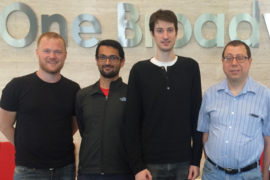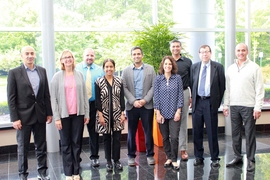When an introductory computational science class, which is open to the general public, was repurposed to study the Covid-19 pandemic this spring, the instructors saw student registration rise from 20 students to nearly 300.
Introduction to Computational Thinking (6.S083/18.S190), which applies data science, artificial intelligence, and mathematical models using the Julia programming language developed at MIT, was introduced in the fall as a pilot half-semester class. It was launched as part of the MIT Stephen A. Schwarzman College of Computing’s computational thinking program and spearheaded by Department of Mathematics Professor Alan Edelman and Visiting Professor David P. Sanders. They very quickly were able to fast-track the curriculum to focus on applications to Covid-19 responses; students were equally fast in jumping on board.
“Everyone at MIT wants to contribute,” says Edelman. “While we at the Julia Lab are doing research in building tools for scientists, Dave and I thought it would be valuable to teach the students about some of the fundamentals related to computation for drug development, disease models, and such.”
The course is offered through MIT’s Department of Electronic Engineering and Computer Science and the Department of Mathematics. “This course opens a trove of opportunities to use computation to better understand and contain the Covid-19 pandemic,” says MIT Computer Science and Artificial Intelligence Laboratory Director Daniela Rus.
The fall version of the class had a maximum enrollment of 20 students, but the spring class has ballooned to nearly 300 students in one weekend, almost all from MIT. “We’ve had a tremendous response,” Edelman says. “This definitely stressed the MIT sign-up systems in ways that I could not have imagined.”
Sophomore Shinjini Ghosh, majoring in computer science and linguistics, says she was initially drawn to the class to learn Julia, “but also to develop the skills to do further computational modeling and conduct research on the spread and possible control of Covid-19.”
"There's been a lot of misinformation about the epidemiology and statistical modeling of the coronavirus,” adds sophomore Raj Movva, a computer science and biology major. “I think this class will help clarify some details, and give us a taste of how one might actually make predictions about the course of a pandemic."
Edelman says that he has always dreamed of an interdisciplinary modern class that would combine the machine learning and AI of a “data-driven” world, the modern software and systems possibilities that Julia allows, and the physical models, differential equations, and scientific machine learning of the “physical world.”
He calls this class “a natural outgrowth of Julia Lab's research, and that of the general cooperative open-source Julia community.” For years, this online community collaborates to create tools to speed up the drug approval process, aid in scientific machine learning and differential equations, and predict infectious disease transmission. “The lectures are open to the world, following the great MIT tradition of MIT open courses,” says Edelman.
So when MIT turned to virtual learning to de-densify campus, the transition to an online, remotely taught version of the class was not too difficult for Edelman and Sanders.
"Even though we have run open remote learning courses before, it's never the same as being able to see the live audience in front of you,” says Edelman. “However, MIT students ask such great questions in the Zoom chat, so that it remains as intellectually invigorating as ever."
Sanders, a Marcos Moshinsky research fellow currently on leave as a professor at the National University of Mexico, is working on techniques for accelerating global optimization. Involved with the Julia Lab since 2014, Sanders has worked with Edelman on various teaching, research, and outreach projects related to Julia, and his YouTube tutorials have reached over 100,000 views. “His videos have often been referred to as the best way to learn the Julia language,” says Edelman.
Edelman will also be enlisting some help from Philip, his family’s Corgi who until recently had been a frequent wanderer of MIT’s halls and classrooms. “Philip is a well-known Julia expert whose image has been classified many times by Julia’s AI Systems,” says Edelman. “Students are always happy when Philip participates in the online classes.”











